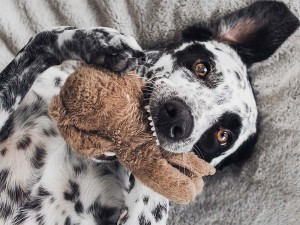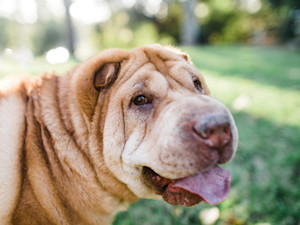Bone Regeneration: From Science Fiction to Fact
Veterinarians help suffering dogs by regrowing bones.

share article

Your pet wants you to read our newsletter. (Then give them a treat.)
Something was wrong with Whiskey, and it wasn’t lethargy, whining or refusal to eat that tipped off his pet parents. It was chew sticks, unchewed. For the 10-year-old Small Munsterlander, chewing was a lifelong obsession. Whiskey’s pet parents, Tom Swierk and Robin Addams, indulged his appetite for beef tendons and other treats. The dog they had acquired as a young pup still had “lots of sass,” as Swierk describes him, or he did until one Thanksgiving, when they realized he had lost interest in chewing, one of his favorite pastimes. When Whisky ignored his chew toys, Swierk thought it was a problem with a tooth, and took him to the vet. It was cancer.
The Search for an Innovative Treatment
Oral cancer, both malignant and benign, is not uncommon in dogs. Unfortunately, Whiskey’s tumoropens in a new tab wasn’t benign. The lesion on his lower left gum was malignant squamous cell carcinoma, the second most common oral malignancy in dogs. In humans, it accounts for 70 percent of all oral tumors.
The wrenching news came with a silver lining: the cancer hadn’t spread to other organs. This type of malignant tumor metastasizes less than 10 percent of the time. It is known for its aggressive growth, however, and the tumor easily invades the jawbone. Nearby were lymph nodes, a ready target and a pathway for the cancer to spread.
The usual course of treatment for malignant squamous cell carcinoma was to amputate the affected bone, sometimes using chemotherapy and radiation. Another common treatment involved shaving the growth but that also means subsequent periodic surgeries. With the diseased bone removed, the chances for a full recovery are good but after amputation, the jaw is never quite the same. The teeth and bones gradually fall out of alignment, and the dog’s teeth can cause ulcerations in the hard palate.
Bone Regeneration in Dogs
As it turned out, there was another option. A team of vets at the University of California, Davis, had been working on a fix for pets who lost jawbone to disease or injury. It had only been used in five other dogs, but the results had been good. Their vet referred him to the UC Davis School of Veterinary Medicine, 73 miles east of San Francisco. The total cost for the procedure ranged from $7,000 to $8,000 per dog. It was a done deal for Swierk and Addams, if that’s what it took to save their dog.
Bone regeneration was seen as science fiction in 1948, when Dr. Marshall R. Urist, a UCLA orthopedic surgeon who pioneered the field, got started. Urist spent five decades at the bone research laboratory at UCLA, where he discovered how to use proteins to stimulate skeletal repair.
In 1971, he proposed the name “bone morphogenetic protein” (BMP) for the growth-promoting factors he used to prompt new bone growth in rabbits. The bone proteins act as signals to stem cells, which migrate to them and are converted into bone-forming cells. These cells then grow bone in the area where the BMP was placed.
Naturally occurring BMP is found within bone, but clinically useful amounts can’t be easily extracted from human donor bone and so must be genetically engineered in the lab.
How Does Bone Regeneration Work?
At UC Davisopens in a new tab, Whiskey was in the care of a team of vets who had been perfecting a new procedure to regrow damaged jawbone, work that drew on Urist’s research and other experimental and clinical treatments developed for humans. The team included Dr. Dan Huey, a biomedical engineer; Dr. Boaz Arzi, a veterinary surgeon; and Dr. Frank Verstraete, who heads the dentistry and oral surgery service at the veterinary teaching hospital. Their goal was to put biomedical approaches to bone replacement to use in veterinary practice. Once they had refined a technique that would work for dogs, they put out the word, and soon referrals from other vets were coming their way. “It wasn’t an experimental study, just an innovative application of existing materials,” Verstraete says.
Over a two-year span, eight dogs have undergone the procedure, and to date, all are doing well, the vets say. Each dog spent three days at the teaching hospital for an exam, surgery and recovery, followed by three post-operative exams.
Whiskey, their sixth patient, had the largest lesion. There was no getting around it: he would lose much of his jaw. But with the help of a titanium plate, a sponge and some bone proteins donated by Pfizer, he would grow a new one in a matter of months.
The team’s first task was to decide how much bone to take in order to remove all of the cancer. That proved to be 2.5 inches, or about half of Whiskey’s lower left jawbone. Once the diseased bone was out, in went a titanium plate built by Dr. Arzi, which was screwed into place on the remaining bone.
Sharing Learned Knowledge
But the titanium plate alone was not enough to hold the jaw together. The greatest risk was failure of the plate due to the large gap where the bone had been, Dr. Verstraete says. Over time, pressure on the plate would cause the surrounding bone to resorb.
Enter the scaffold: a stiff, sponge-like piece of material that was fitted into the space. It, too, was only part of the solution. The next step in building a new jaw would require Whiskey’s own stem cells, attracted to the bone proteins in which the scaffold had been soaked. Like a magnet, the bone proteins would draw stem cells from the dog’s surrounding bone and soft tissue to the scaffold, where they would attach and turn into bone cells, according to Dr. Huey. The new bone cells would eventually fill the entire void and integrate with native bone. On a molecular level, the new bone is the dog’s own, with a DNA makeup identical to other bones in his body.
There is no need to match the proteins to a particular dog, Verstraete says. “The BMP we use is synthetic, recombinant human (rhBMP-2). It doesn’t elicit any antibody response in experimental animals.”
Just as the vets borrowed from human medicine, their procedure for dogs will now find its way back into human medicine. Their success with the eight cases has given them material for a report on the work, which they plan to submit to a scientific journal.
What Lies Ahead For the Promising Surgery?
The vets hope to be able to modify the technique for use with larger jawbone defects in animals. Also on the horizon: human arm and leg bones. There is more work to be done, however. “The technique that we used has not been done for weight-bearing bones yet,” Verstraete says.
Is the new method a cancer cure, or a quality-of-life issue? “Both,” Verstraete says. “We only do the surgery for tumors that haven’t spread. Reconstruction greatly improves the quality of life compared to the previously used technique.”
As for Whisky, Swierk knows there’s no guarantee that Whiskey will remain cancer-free. “The assumption is that it’s a cure, but the verdict is still out.” But based it’s “so far, so good.” The bionic jaw is doing its job and Whisky’s back and he’s chewing up all his yummies as he did before.
Sheila Pell
Sheila Pell is a freelance journalist who frequently writes about environmental issues. Her work has appeared in The Washington Post, Modern Farmer, San Diego Reader, The Bark, and American Forests. She lives in northern California with her husband and two large dogs.
Related articles
![Dalmatian mix breed dog is playing with a dog toy on a soft surface]() opens in a new tab
opens in a new tabDigging into the Fine Print of Pet Insurance
Risk Management: Understanding pet insurance plans.
![]() opens in a new tab
opens in a new tabCancer is More Common in Purebred Dogs, Study Says
Nationwide’s veterinary analytics team looked at the cancer claims of 1.61 million dogs and found that purebred dogs are nearly twice as likely to get cancer as mixed breeds.
![Shar pei]() opens in a new tab
opens in a new tabLipomas in Dogs: Causes, Symptoms and Treatment of Fatty Tumors
Here’s why you (probably) shouldn’t worry.
![Girl Carefully Hugs A Sick Lying Dog]() opens in a new tab
opens in a new tabHow Pet Hospice Can Help When It’s Nearly Time
Veterinary hospice and palliative care expert Dr. Shea Cox, DVM, on an alternative to euthanasia.





